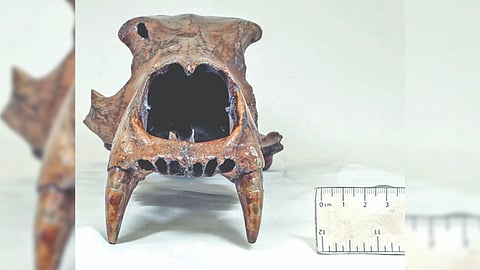

LUCAS JOEL
It’s called the Los Angeles River but it’s really a 51-mile stretch of concrete. In the 1930s the U.S. Army Corps of Engineers started lining the waterway to limit the risk of flooding in the rapidly growing city.
Now work is underway to make the river more like what it once was. In a segment called the Bowtie parcel, scientists are seeking to transform what was once a busy rail yard into a place where life can thrive again, and where people can go and enjoy nature.
“The hardest thing is to see something that isn’t there, so you need to help make the invisible visible,” said Lewis MacAdams, a poet and activist for bringing nature back to the L.A. River, before he died in 2020.
He shared that idea with Kat Superfisky, an urban ecologist with the City of Los Angeles who works on the river. But when so much of the life that existed along the river was erased long ago by concrete, how do you make the invisible visible? Part of the answer involves studying organisms that died within the past 60,000 years or so.
Along the L.A. River and in other parts of the world, the Earth’s fossil record is helping inform the preservation and enhancement of natural landscapes.
It’s part of a growing field called conservation paleobiology, which aims to use dead and buried life to help scientists like Ms. Superfisky accomplish their goals.
The La Brea Tar Pits — natural pits of pitch black tar that, over millenniums, have trapped and entombed things that lived in Southern California — sit about eight miles west of the L.A. River.
Fossils found in the tar include everything from saber-tooth cats, giant ground sloths, dire wolves and grizzly bears to plants like oak trees and juniper.
The pits are a far cry from the image of a pristine river. Nevertheless, they’re windows into the life that once flourished in the region, and which may flourish there again. Jessie George, who recently received her Ph.D. from the University of California, Los Angeles, studies fossil plants at the tar pits.
During a tour of the site, she explained that fossils can reveal how past life fared during ancient episodes of climate change. In our age of human-driven climate change, Dr. George explained, that’s critical information for work along the river.
“We have these different windows of different habitats from different times,” said Dr. George as she crouched over the tarred bones of a dire wolf and some juniper seeds. “We can see how they’re responding to climate in real time.”
Juniper, for instance, is native to Southern California. But according to the fossil record, the plant doesn’t fare well in a warming world. “Juniper is really sensitive to those periods of warming,” said Regan Dunn, a paleobotanist at the tar pits.
“We look at those intervals that are hottest, and juniper is having a massive die-off in the Southwest.”
But the fossil record of oak trees — specifically, a type called coast live oak — tells a different story, of resilience through tumultuous times. “It spans almost the entire record, and has persisted across a wide range of environmental changes,” Dr. George said. “It has faced repeated, short-term warming and cooling events.”
Such information is helpful to Sophie Parker, a scientist with The Nature Conservancy, which alongside California State Parks is leading the effort to enhance the Bowtie parcel. She can use it to determine which plants to turn to as the Bowtie work unfolds.
Lucas Joel is a journalist with NYT©2022
The New York Times
Visit news.dtnext.in to explore our interactive epaper!
Download the DT Next app for more exciting features!
Click here for iOS
Click here for Android